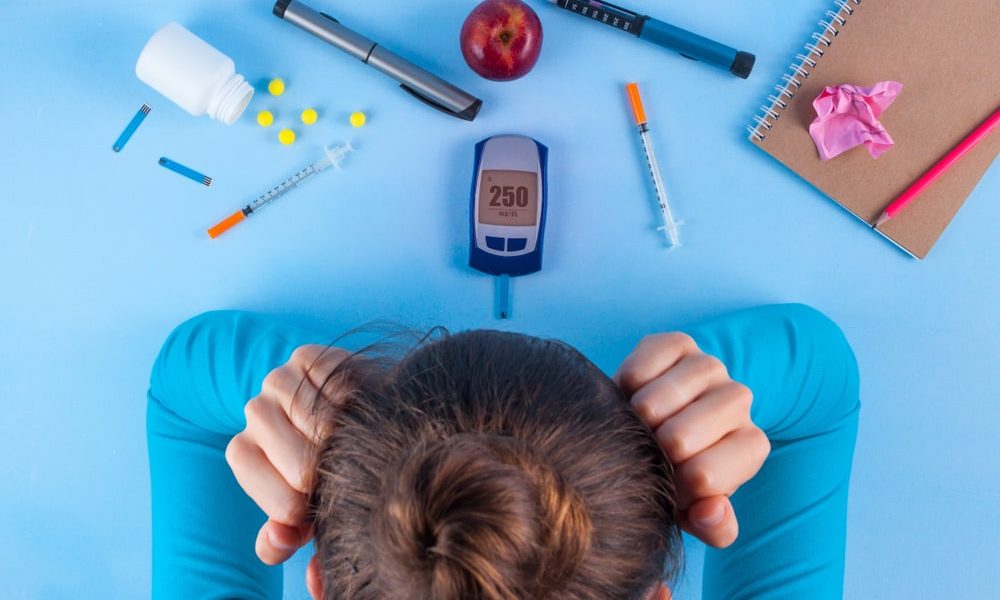Blood sugar fluctuates throughout the day. However, having persistently high blood glucose levels can lead to chronic health issues.
Hyperglycemia, often known as high blood sugar, is a significant problem for people with diabetes. Not taking the right actions may result in long-term metabolic health impairment.
The body needs enough energy to survive and perform at its best. The body’s internal systems require energy to maintain life, even while resting. The only source of energy for the human body is food. It contains carbohydrates, proteins, fats, and trace amounts of vitamins, minerals, and salts. The body breaks down this complex ingested food into various simpler components.
Carbohydrates make up a significant portion of the diet. They break down into glucose (a type of sugar) in the stomach and the small intestines.
The bloodstream then absorbs glucose from the body. As a result, the words “blood sugar levels” and “blood glucose levels” are synonymous.
Glucose is the primary energy source for almost all body parts. It is the only energy source for the brain and is thus extremely important for survival. Maintaining an optimum level is critical as all the organs receive glucose through blood.
The regulation of the blood glucose level relies on many interdependent processes involving multiple body systems. When these processes function harmoniously, the blood sugar levels stay within normal ranges. Certain internal or external factors, however, do disturb normal functioning leading to instability of blood glucose levels.
Making the right food choices is made easier with HealthifyPro 2.0. Finding the relationship between blood glucose levels and diet is a simple process.
Continuous Glucose Monitoring (CGM) technology allows one to discover foods and how much activity they need to maintain healthy blood sugar levels. Thus, the HealthifyMe coaches can assist their clients in understanding which foods are better for their bodies.
In addition, HealthifyPro coaches can help create individualised meal plans to help them manage and optimise their glucose spikes.
Blood Sugar Levels – Measurement and Normal Values
The best way to prevent hyperglycemia is by practising diabetes management. In addition, early detection of the hyperglycemic condition will aid in treating it before it worsens. Several types of tests to measure blood sugar levels are:
Fasting Blood Glucose
Fasting blood glucose works by checking the blood glucose level after 8 – 10 hours of fasting, preferably overnight. The appropriate value per the American Diabetes Association (ADA) is below 100 mg/dL. Also, ADA stratifies the subjects according to test results.
- Normal Range: <100 mg/dL
- Prediabetes: 100 mg/dL to 125 mg/dL
- Diabetes: >125 mg/dL
Post-Prandial Blood Glucose Test
Post-prandial blood glucose test measures blood glucose approximately 2 hours after a meal.
- Normal: Values less than 140 ml/dL
- Prediabetes: Values between 140 ml/dL – 200 mg/dL
- Diabetes: Values more than 200 mg/dL
Random Blood Sugar Test
Random blood sugar level monitoring can measure blood sugar range at any time throughout the day.
- Normal: Values less than 140 ml/dL
- Prediabetes: Values between 140 ml/dL – 200 mg/dL
- Diabetes: Values more than 200 mg/dL
Oral Glucose Tolerance Test
This test involves the administration of a syrupy liquid after 8 hours of fasting. The liquid contains about 75 grams of glucose. Also, the blood glucose level is measured 2 hours after administration of this liquid.
- Normal: Values less than 140 ml/dL
- Prediabetes: Values between 140 ml/dL
- Diabetes: Values more than 200 mg/dL
Out of all these tests, any two values over 200 mg/dL need medical attention.
A1C Test
The A1C test shows the average blood glucose levels for the last three or six months. So, another name for the test is the Estimated Average Glucose (eAG) Level test.
The consultant physician decides the frequency of A1C tests. It can range from 2 to 6 times a year. Results below 5.7% are normal. An A1C level of 7% corresponds to an estimated average glucose (eAG) level of 154 mg/dL.
The categorisation of A1C results includes:
- Normal: Below 5.7%
- Prediabetes: 5.7% to 6.4%
- Diabetes: Above 6.5%
13 Reasons that Raise Blood Glucose Levels
Excess Body Fat and Insulin Resistance
Research infers obesity is a significant cause of high blood sugar. Excess body fat influences the insulin taken up by body tissues. It frequently leads to a disorder called insulin resistance.
In this disorder, the muscles, liver, and fat tissue cannot utilise glucose from the blood. It happens due to various reasons like obesity and immune response to insulin.
The pancreas keeps on producing insulin in increasing amounts. This high insulin concentration either makes the body insensitive or develops insulin resistance. Finally, the pancreas cannot meet increasing insulin requirements and is in hyperglycemic condition.
According to a study, about 25% of adults above 20 develop insulin resistance. In 10 to 15 years of prevalence, it can lead to type 2 diabetes mellitus.
Hormonal Changes
Hormones form the basis of glucose balance in the bloodstream. Therefore, factors like physical pain and trauma, menopause or menstruation, stress, and sleep deprivation can cause hormonal imbalance, resulting in hyperglycemia.
Medications
Administration of certain drugs like steroids, beta-blockers, some antipsychotics, and a few antibiotics interfere with various chemical processes in the body to cause raised blood sugar.
Damage to Intestinal Microbes
Extensive use of antibiotics or resistant infections damages the essential, healthy microbes in the intestines. Research shows a link between damaged intestinal microbes and increased blood glucose levels. In addition, it shows that glucose metabolism related to type 2 diabetes can result from damage to the intestinal microbes.
The intestinal microbes can enhance the production of the incretin hormone, a gut peptide that promotes insulin production. They also produce short-chain fatty acids that are key in controlling blood sugar.
Gut microorganisms have an anti-obesity effect by modifying the fat tissue. It also aids in maintaining healthy blood glucose levels. There are several studies supporting this phenomenon.
Genes
Genes play a huge role in causing diabetes. Autoimmune diseases like diabetes, a combination of genetics, lifestyle factors, and environment play a vital role.
The risk of developing diabetes increases by specific variants of the HLA-DQA1, HLA-DQB1, and HLA-DRB1 genes. However, the exact causes of diabetes are not yet known.
Processed Foods and Artificial Sweeteners
Diet affects every individual differently. But there is an observable trend of certain foods prone to cause diabetes. For example, processed foods with more sugar, fat, and artificial sweeteners can spike blood sugar. Research highlights the role of artificial sweetener sucralose in elevating serum glucose.
Overeating
It was an old suggestion to keep chewing on something to stabilise the levels. Modern research, however, negates this norm. So instead, an information update advises just two large meals and strict fasting for about 12 hours.
A study showed that eating two large meals helped reduce blood glucose better than six small meals (daily). Having appropriate amounts at meal time is one more piece of advice. Having a feeling of 75 to 80% stomach fullness is desirable. Overeating, too, causes a blood sugar surge.
Dehydration
Research states that the amount of water you drink is inversely proportional to the risk of developing diabetes mellitus. One reason is that reduced water content automatically increases blood sugar concentration. But, a vasopressin mechanism is also in action.
Dehydration causes the release of the vasopressin hormone. It will make the kidneys retain more water, and the liver secrete more glucose. Having less water according to environmental conditions is one possible cause of hyperglycemia.
Vitamin and Mineral Deficiencies
Studies suggest a deficiency in micronutrients like chromium, magnesium, or vitamin D contributes to high blood glucose. There have also been several experiments administering vitamin supplements to people with diabetes. They have successfully controlled blood sugar in some cases.
Physical Inactivity
Muscles absorb about 70% of the glucose in the blood. Movement of the body and physical stress make muscles work more, leading to increased glucose consumption. It will eventually lower blood glucose levels.
A study suggests that physical inactivity is closely related to insulin resistance via at least nine molecular mechanisms. Many other research papers point out a link between the two. In addition, physical inactivity reduces obesity and thereby reduces diabetes and also the interaction between the two disorders.
Stress
Stress may take any form ranging from depression and anger to hostility. Research states that not only depression but stress in any form can predispose to type 2 diabetes mellitus. The mechanism is quite simple, which includes the production of extra glucose comprising the body’s fight-or-flight response.
Stress of any sort is one primary stimulus that triggers this mechanism. In addition, this mechanism releases the hormone cortisol, which reduces insulin sensitivity. As a result, it will attenuate insulin resistance and increase blood sugar levels.
Poor Sleeping Patterns
Sleep deprivation leads to a reduction in insulin production. Extensive research into various mechanisms suggests that sleep deprivation increases diabetes risk.
It is more common among people working alternate night shifts. Apart from these, some physiological and routine phenomena cause frequent spikes, especially in people with diabetes. These are:
- Sunburn
- Coffee
- Skipping breakfast leads to increased blood sugar after having lunch and dinner.
- Late in the day, there can be a rise in the blood sugar level.
- Dawn phenomenon: The hormone levels rise early in the morning. In diabetics, this can raise blood sugar levels.
Other Health Conditions
Certain diseases or illnesses can also contribute to high blood sugar. It includes Cushing’s disease, acromegaly, polycystic ovarian syndrome, hypothyroidism, gestational diabetes, pancreatic cancer, cystic fibrosis, pancreatitis, and other conditions. Surgery, trauma, and even the common cold or flu could be other possible causes.
The HealthifyMe Note
Diabetes Mellitus is one of the prevalent health issues worldwide. One of the most common health problems worldwide is diabetes mellitus. Excess body fat and insulin resistance, hormonal changes, medications, genes, damage to intestinal microbes, artificial sweeteners, processed foods, an inactive lifestyle, stress, sleep disturbances, dehydration, overeating, a lack of vitamins and minerals, and other factors can all cause blood glucose levels to rise.
Managing High Blood Sugar Levels
The medical management of high blood sugar needs a medical consultation. However, it is only supportive. These reasons mentioned above require simple yet effective day-to-day diabetes management.
- Lifestyle Changes- Maintaining an active lifestyle helps burn calories and reduce blood glucose. For example, one can try walking out more than driving, doing physical sports, etc.
- Exercise- Exercise is a crucial element of diabetes management. The elderly can resort to flexibility exercises, whereas youth can try resistance training. Endurance exercises and cardio are also good choices. Yoga is something that’s fitting for everyone.
- Destressing the Mind- Practising stress relaxation techniques or consulting a psychiatrist is advisable if coping with stress is complex.
- Diet Prescription and Monitoring- Consulting an expert dietician and following a recommended plan suits most diabetics. However, regularly monitoring dietary norms and following the guidelines is a strict mandate.
- Meditation- Meditation helps cope with mental as well as physical stress. It helps in harmonising the body and mind. It increases the body’s awareness and keeps individuals alert to danger signals. It will also keep one relaxed and thoughtful at every action.
The HealthifyMe Note
The fact that diabetes is a silent killer is well known. However, making a few lifestyle changes, such as exercise, healthy food choices, meditation, and regularly monitoring blood glucose, will help people assess their response to treatment and lifestyle changes and establish a pattern.
Conclusion
Surging causes of hyperglycemia can be stressful for everyone. But as with other diseases, the secret to getting the best treatment is understanding the cause. The best management approach should monitor risk indicators and make deliberate health changes.
Regular blood sugar monitoring is one investigation that can help track your progress and sustenance. The central part of management lies in the patients’ hands as it is more or less non-medical oriented.
Appropriate actions and a structured management program are necessary for a better quality of life for everyone.


